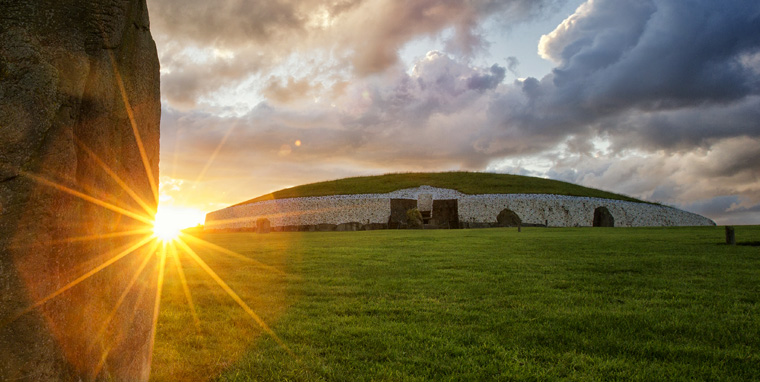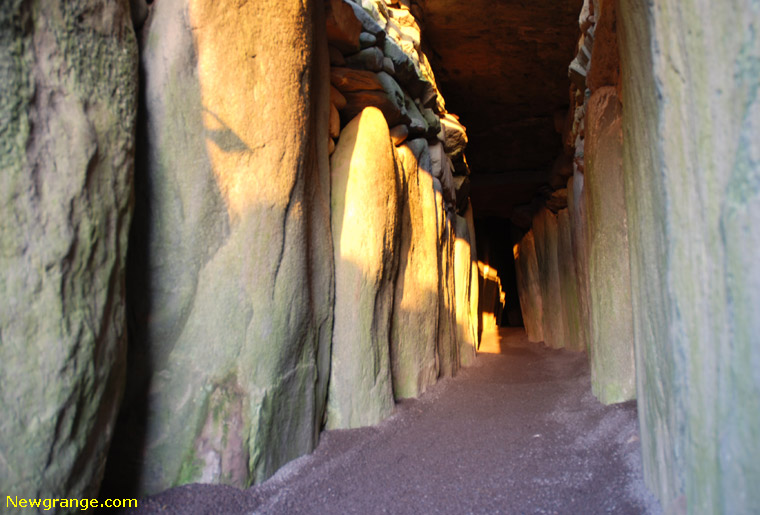An Irishman's Diary by Kevin Myres
Printed in The Irish Times | 6 September 1990Back to Newgrange again. Why? Because it is simply the most astounding thing in all of Ireland, all of Europe even, and I am so awestruck by it that I might just spend the rest of my life writing about it.
To be there in the very bottom of the passage grave when the sun peers in on the midwinter solstice like a nosy neighbour must be one of the most extraordinary sensations known to human experience. It must give a view of time and space that completely dwarfs any normal speculation about such matters. For there in that grave on that morning Einstein is vindicated and was vindicated five thousand years before he was born.
Simultaneously one sees both the horrors of mortality and the yawning infinity of the history of space all encapsulated in stone on a Meath hillside. It is as if we have learnt nothing fundamental in the past five millennia. What was known to those builders is all that one needs to know; the rest is flotsam which will be carried away by the next tide and be forgotten.
The Solstice Dawn
And unless somebody has programmed a cruise missile to enter the mouth of the passage and to proceed the 19 yards to where the stone captures the solstice dawn, that construction will outlast us all, and when mankind has passed from this planet and the empire of insects takes over, that grave will be yearly offering its hospitality to the risen sun's first rays of the new year - until of course the tilt of the earth, shifting microscopically, points the incredible sun-seeking corridor out of alignment.Society does not often choose its heroes wisely. We commemorate people who have engaged in violence rather than peace: no monument rests for Mary Aikenhead who brought medical care to the poor of Dublin, nor the person who was responsible for, say, installing plumbing in the capital city. And no monument exists to Professor M.J. O'Kelly, the UCC archaeologist who discovered that Newgrange was a precise astronomical clock, and who supervised the reconstruction of the outer stonework during the 1970's.
No monument, that is, other than the site itself; but surely at least a plaque should be erected - at least - to this extraordinary man. There might be a debate amongst archaeologists about the suitability of reconstructing the site so that is resembles what it might originally have looked like. Many would hold that archaeologists should conserve, not restore. But in this case the deed is done.
The Office of Public Works continues to develop the site. Work on conserving the rear of the mound to prevent slippage of the stones has just been completed under the eye of Ann Lynch. She has been astonished by the sheer volume of stone which was assembled on the hill, and recent excavations confirm what was already suspected that the work-force responsible for Newgrange did not, unlike those on the nearby Knowth site, actually live on the site. They were Neolithic commuters. And she believes that the Neolithic commuters learnt from their errors at Newgrange, where they built a vertical wall unsupported by layers of sod. There is good reason to believe it fell over fairly quickly.
When Neolithic engineers came to construct Knowth and Dowth they learnt from the Newgrange experience.
Newgrange attracts about 150,000 visitors a year and when the OPW has finished the archaeological park which will establish an explanation to it and the neighbouring sites of Knowth and Dowth, it will attract many more, to the site and to Meath generally. Let us hope that they do not experience what I experienced last Saturday when I tried to get some lunch.
Every pub which advertised food said that they do not serve on Saturdays, as if the alimentary canal takes the weekend off. And finally in despair, though nonetheless suspecting what might befall me, I tried something I shall call Mighty Meatballs (not its real name).
It is one of the features of a country that has existed from one colonial system but aspires to join another that it attempts to mimic its future masters, and does so, so incompetently and with such lack of discernment that the essentials are lost and the worst superficial parodies of the model retained.
The essence of American fast food outlets is that they are fast and clean and that they represent the eating style of a vigorous entrepreneurial society, regardless of the vulgarity of appearances.
All that Mighty Meatballs has retained is this last: it is an eyesore which, festooned with great and ghastly plastic signs, is a rebuke to the planning processes in Meath. But having achieved requisite levels of vulgarity it abandons all other requirements of American fast food restaurants.
It is scruffy. It advertised various forms of chicken but did not have any. I chose a hamburger instead and what were called French fires, the production of which took nearly 10 minutes. I asked for a soft-drink but the soft-drink machine was out of order and so there were no soft-drinks, as if it was impossible to stock up with soft-drinks from the local supermarket. So much for enterprise culture.
Refried Frozen Chips
What were called French fries were nothing like the French fries of American burger joints but soggy and greasy refried frozen chips. I could eat neither chips nor burger and threw the whole lot into the bin that Mighty Meatballs so kindly and so prudently reserves for its products.To there within a relatively short distance of one another we have two undertakings, the state of one, which is full of imagination and enterprise and make a triumph of the past, and the private one, dismal, unimaginative and promising a grisly future (and the only reason I have not named it is so the poor girls working there will not be punished by the insensate brute responsible for building it).
Boyne Valley Private Day Tour
 Immerse yourself in the rich heritage and culture of the Boyne Valley with our full-day private tours.
Visit Newgrange World Heritage site, explore the Hill of Slane, where Saint Patrick famously lit the Paschal fire.
Discover the Hill of Tara, the ancient seat of power for the High Kings of Ireland.
Book Now
Immerse yourself in the rich heritage and culture of the Boyne Valley with our full-day private tours.
Visit Newgrange World Heritage site, explore the Hill of Slane, where Saint Patrick famously lit the Paschal fire.
Discover the Hill of Tara, the ancient seat of power for the High Kings of Ireland.
Book Now
Home
| Visitor Centre
| Tours
| Winter Solstice
| Solstice Lottery
| Images
| Local Area
| News
| Knowth
| Dowth
| Articles
| Art
| Books
| Directions
| Accommodation
| Contact



